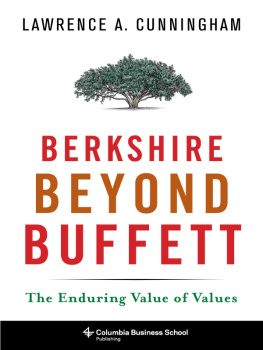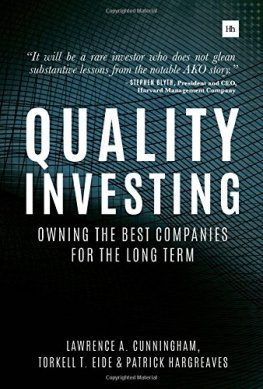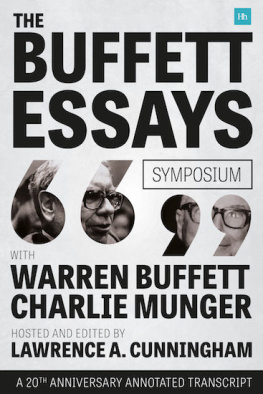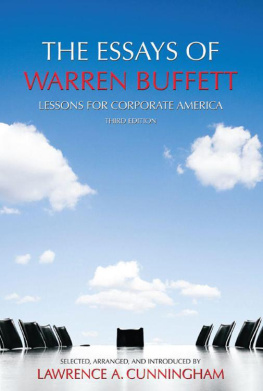Table of Contents
Quality Shareholders
Quality Shareholders
How the Best Managers Attract and Keep Them
Lawrence A. Cunningham
COLUMBIA UNIVERSITY PRESS
NEW YORK
Columbia University Press
Publishers Since 1893
New York Chichester, West Sussex
cup.columbia.edu
Copyright 2020 Lawrence A. Cunningham
All rights reserved
E-ISBN 978-0-231-55277-6
Library of Congress Cataloging-in-Publication Data
Names: Cunningham, Lawrence A., 1962 author.
Title: Quality shareholders: how the best managers attract and keep them / Lawrence A. Cunningham.
Description: 1e. | New York City: Columbia University Press, 2020. | Includes index.
Identifiers: LCCN 2020011456 (print) | LCCN 2020011457 (ebook) | ISBN 9780231198806 (cloth) | ISBN 9780231552776 (ebook)
Subjects: LCSH: Stockholders. | CorporationsInvestor relations. | Investments. | Stocks.
Classification: LCC HD2744 .C86 2020 (print) | LCC HD2744 (ebook) | DDC 659.2/85dc23
LC record available at https://lccn.loc.gov/2020011456
LC ebook record available at https://lccn.loc.gov/2020011457
A Columbia University Press E-book.
CUP would be pleased to hear about your reading experience with this e-book at .
Cover design: Noah Arlow
Cover image: Shutterstock
Quality is never an accident;
it is always the result of intelligent effort.
John Ruskin
Contents
Prologue:
The Shareholders Managers Deserve
1
Meet the Quality Shareholders
2
Comparative Advantages
3
Competitive Advantages
4
The Corporate Message
5
Annual Letters
6
Annual Meetings
7
Quality Quarterly Contact
8
Useful Metrics
9
Capital Allocation
10
Trackers and Spins
11
Director Selection: Stewards, Advocates, or Walkovers?
12
Managerial Performance: The Overpaid and Underpaid
13
Shareholder Voting: One Each, Dual Class, or Quality?
Epilogue:
Getting Indexers and Activists Going Quality
Appendixes:
A. Research, Method, and Names
IN 2013, SHAREHOLDER ACTIVIST TRIAN Partners and its leader, Nelson Peltz, targeted E. I. du Pont de Nemours & Co. (DuPont) and CEO Ellen Kullman. For two years, the sides debated DuPonts conglomerate structure, capital allocation, corporate overhead, and governance. When they hit a stalemate, Peltz nominated himself and three directors for the DuPont board at its annual shareholders meeting on May 13, 2015. Peltz lost the battle by a thin margin; Kullman soon retired anyway, effectively losing the war; and DuPont morphed into Dow DuPont through a series of maneuvers. To this day, it is not obvious whether anyone won, shareholders included.
The shareholder base was typical of todays U.S. public companies: besides insiders owning 0.3 percent and the activist having acquired 2.7 percent, DuPont was owned by a mix of index funds, short-term transients, long-term concentrated owners, pension funds, insurance companies, and individuals. Among larger holdings, ten of todays largest mutual funds commanded 33 percent of the vote. Both sides lobbied them intensively, spending $23 million between them.
The margin of victory was 3.5 percent, meaning a different outcome if any one or two of those large shareholders switched sides. While it was natural for DuPont to swing into action when targeted, it could have vanquished its opponent had Kullman and her team cultivated a different shareholder base, one more in tune with her strategic vision for DuPont. Sculpting the shareholder base, bringing shareholders together, adds value in multiple ways for management, shareholders, and companies as a whole.
As an officer and director of a private corporation, I help decide whether or not to permit applicants to become fellow shareholders in our firm; as a public company director, neither I nor anyone else has such veto power. But while anyone can buy stock in a public company, that does not prevent companies from sculpting their shareholder base to attract some shareholders and repel others. In fact, given todays diversity of shareholder types based on time horizon and commitment levels, it is more important than ever to do so.
There are few ways public companies can prevent or expel given shareholders from buying or holding the stock. Through the 1980s, companies could buy out undesirable shareholders for a premium, a practice called greenmail. Once used by incumbent boards targeted by corporate raiders, its not been used for decades due to its odious character, unfavorable tax laws (gains are subject to punishing excise taxes), and more effective alternatives such as poison pills.
Short-termism remains a major concern. In the mid-1990s, a few rogue shareholders of Warren Buffetts Berkshire Hathaway planned to buy yet more of its pricey shares and deposit them into trusts that would, in turn, issue fractional interests at vastly lower unit prices. The trusts would attract short-term traders. That would undercut everything Buffett was trying to accomplish with Berkshires cultivation of long-term committed shareholders.
To protect against that, Berkshire in 1996 effected a dual-class recap through which one class (the A class) would continue pretty much as before as a high-end stock, but a newly issued class (the B class) would bear fractional economic and voting interests and trade at a lower price. In this way, though Berkshire could not prevent the repellent shareholders from buying for themselves, it did inhibit them from buying at the levels needed for their unit trust plan. Short-term traders were deterred.
Indexers are todays dominant shareholder cohortfunds buy small stakes in all stocks in a defined index such as the S&P 500 or Russell 3000. While indexers helpfully offer the masses low-cost market returns, debate rages on whether they are capable of casting informed opinions in votes at the huge number of companies they hold stakes in. Managers sharing that concern can adopt policies that S&P and other index managers use to exclude companies from their index, such as dual-class voting, majority owners, or tracking stock.
Shareholder activists such as Peltz have since 2000 become a conspicuous, well-financed, and well-organized force in corporate life. Most officers and directors appreciate that the best way to avoid being targeted is to execute successfully on a reliable strategy delivering corporate prosperity. But it is equally important to ensure having a shareholder base that is more willing to agree with management, and its strategy, rather than one susceptible to an activist shareholders challenges.
Many managers use their bully pulpit to deter shareholders unaligned with their corporate philosophy. At a Starbucks shareholders meeting, Howard Schultz told a shareholder challenging the companys hiring practices that he should sell the stock. Joe Steinberg so advised a Leucadia shareholder challenging the companys hold-or-divest policies. In a 2014 letter to shareholders of the Washington Post Co., Don Graham stressed the companys long-term outlook, adding: If you are a shareholder and YOU care about our quarterly results, perhaps you should think about selling the stock.
While hectoring can be an effective deterrence strategy, this book explores dozens of corporate practices and policies that shape the shareholder base to attract long-term committed owners. Examples: publishing long-term performance metrics; stating capital allocation policies; effecting strategic spin-offs; and establishing shareholder-oriented board selection criteria, voting arrangements, and executive pay practices. Managers can consciously deploy such tools to attract and reward desired shareholders and repel others.















